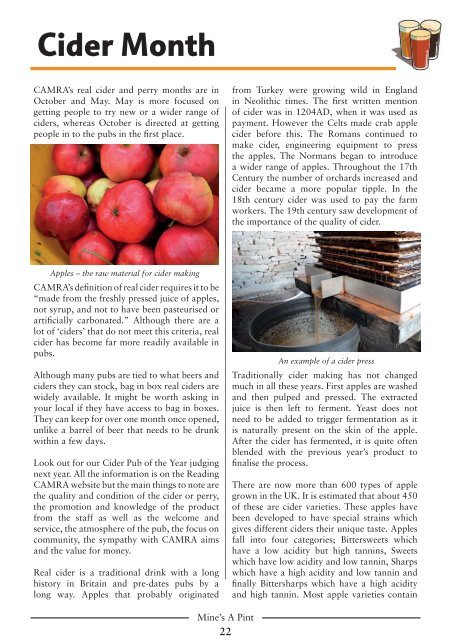Mine's a Pint - Autumn 2019
The Autumn 2019 edition of the magazine of the Reading & Mid-Berkshire Branch of the Campaign for Real Ale (CAMRA).
The Autumn 2019 edition of the magazine of the Reading & Mid-Berkshire Branch of the Campaign for Real Ale (CAMRA).
Create successful ePaper yourself
Turn your PDF publications into a flip-book with our unique Google optimized e-Paper software.
Cider Month<br />
CAMRA’s real cider and perry months are in<br />
October and May. May is more focused on<br />
getting people to try new or a wider range of<br />
ciders, whereas October is directed at getting<br />
people in to the pubs in the first place.<br />
from Turkey were growing wild in England<br />
in Neolithic times. The first written mention<br />
of cider was in 1204AD, when it was used as<br />
payment. However the Celts made crab apple<br />
cider before this. The Romans continued to<br />
make cider, engineering equipment to press<br />
the apples. The Normans began to introduce<br />
a wider range of apples. Throughout the 17th<br />
Century the number of orchards increased and<br />
cider became a more popular tipple. In the<br />
18th century cider was used to pay the farm<br />
workers. The 19th century saw development of<br />
the importance of the quality of cider.<br />
Apples – the raw material for cider making<br />
CAMRA’s definition of real cider requires it to be<br />
“made from the freshly pressed juice of apples,<br />
not syrup, and not to have been pasteurised or<br />
artificially carbonated.” Although there are a<br />
lot of ‘ciders’ that do not meet this criteria, real<br />
cider has become far more readily available in<br />
pubs.<br />
Although many pubs are tied to what beers and<br />
ciders they can stock, bag in box real ciders are<br />
widely available. It might be worth asking in<br />
your local if they have access to bag in boxes.<br />
They can keep for over one month once opened,<br />
unlike a barrel of beer that needs to be drunk<br />
within a few days.<br />
Look out for our Cider Pub of the Year judging<br />
next year. All the information is on the Reading<br />
CAMRA website but the main things to note are<br />
the quality and condition of the cider or perry,<br />
the promotion and knowledge of the product<br />
from the staff as well as the welcome and<br />
service, the atmosphere of the pub, the focus on<br />
community, the sympathy with CAMRA aims<br />
and the value for money.<br />
Real cider is a traditional drink with a long<br />
history in Britain and pre-dates pubs by a<br />
long way. Apples that probably originated<br />
An example of a cider press<br />
Traditionally cider making has not changed<br />
much in all these years. First apples are washed<br />
and then pulped and pressed. The extracted<br />
juice is then left to ferment. Yeast does not<br />
need to be added to trigger fermentation as it<br />
is naturally present on the skin of the apple.<br />
After the cider has fermented, it is quite often<br />
blended with the previous year’s product to<br />
finalise the process.<br />
There are now more than 600 types of apple<br />
grown in the UK. It is estimated that about 450<br />
of these are cider varieties. These apples have<br />
been developed to have special strains which<br />
gives different ciders their unique taste. Apples<br />
fall into four categories; Bittersweets which<br />
have a low acidity but high tannins, Sweets<br />
which have low acidity and low tannin, Sharps<br />
which have a high acidity and low tannin and<br />
finally Bittersharps which have a high acidity<br />
and high tannin. Most apple varieties contain<br />
Mine’s A <strong>Pint</strong><br />
22

















